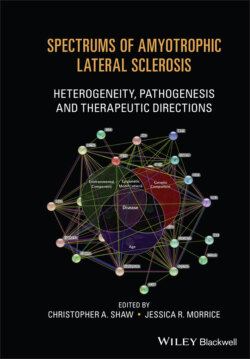Читать книгу Spectrums of Amyotrophic Lateral Sclerosis - Группа авторов - Страница 43
Epigenetics
ОглавлениеEpigenetic modifications, such as post‐translational histone modifications and DNA methylation, are a mostly unexplored area of ALS genetic etiology. These modifications tend to increase or decrease the expression of genes, rather than alter the function of the gene directly. Because these marks can be impermanent, modulation of these modifications might lead to new therapeutics. However, because post‐transcriptional and post‐translational modifications tend to be ubiquitous and varied in usage across the genome and cell types, it will require a targeted and informed approach to manipulate these modifications. Two examples of epigenetic study are those of CpG islands in and around the C9orf72 HRE and genome‐wide histone acetylation.
Penetrance of the C9orf72 HRE is strongly age‐dependent, ranging from 60% at 60 years old to over 90% at 80 years old [8]. If cellular modulation could lower the expression of the C9orf72 HRE, perhaps this would explain the large variance in age at symptom onset for HRE carriers. Since promoter methylation allows for the restricted expression of the downstream gene, several studies have shown a link between methylation of a promoter sequence upstream of the C9orf72 gene and lowered transcription of the HRE [93–95]. The promoter is only hypermethylated in cis with the HRE [93], and non‐carriers show little to no methylation [94].
The C9orf72 HRE is a repeat of (GGGGCC)n and is therefore composed of several potential CpG sites. Whether this is of consequence to ALS genetic etiology is still in question. Early reports did not observe methylation of the HRE itself [93], but later experiments demonstrated size‐dependent methylation of the HRE [96, 97]. Since the C9orf72 HRE shows somatic instability when expanded [43], the methylation status of the HRE itself could be of interest in terms of cell‐specific effects and time/age‐dependent aspects. Indeed, both repeat dipeptide proteins and RNA foci are reduced in cell models of methylated HRE [97]. Whether this differential methylation is modifiable is another important consideration, since methylation patterns and age are closely correlated [98]; whether aging changes methylation patterns and therefore gene expression, or whether changes in methylation patterns result in increased aging, is unknown (for a thorough review on genomic considerations of epigenetic changes and aging, refer to Pal and Tyler [99]).
Another level of epigenetic regulation of gene expression is that of histone modifications or post‐translational modifications. Observations of an upregulated microRNA (miR‐206) in a transgenic hSOD1 p.G93A mouse model led to speculation that its target mRNA, histone deacetylase 4 (HDAC4), could implicate chromatin remodeling in ALS [100]. Further, in ALS patients with more rapid symptom progression, HDAC4 expression was found to be upregulated, and muscle reinnervation was lessened [101]. If miR206 targets and lowers the expression of the muscle‐specific HDAC4, and HDAC4 decreases muscle reinnervation, it would follow that the protective effects of miR206 could be reproduced by inhibiting the action of HDAC4. Broadly inhibiting Class II HDAC proteins was found not to be effective in increasing ALS survival in hemizygous hSOD1 p.G93A mice, although glutamate receptor uptake was restored [102]. Inhibiting HDAC4 directly in mouse skeletal muscles through knockout led to worsened symptoms and disease severity [103]. Even though increased expression of HDAC4 correlates with ALS symptoms, its inhibition also leads to worsened symptoms [103, 104]. Unfortunately, although current research can identify modified pathways and responses to ALS cellular pathology, a clear picture of epigenetic regulation is not yet available for ALS, and further research will be needed before inhibitors can be used therapeutically [104].
